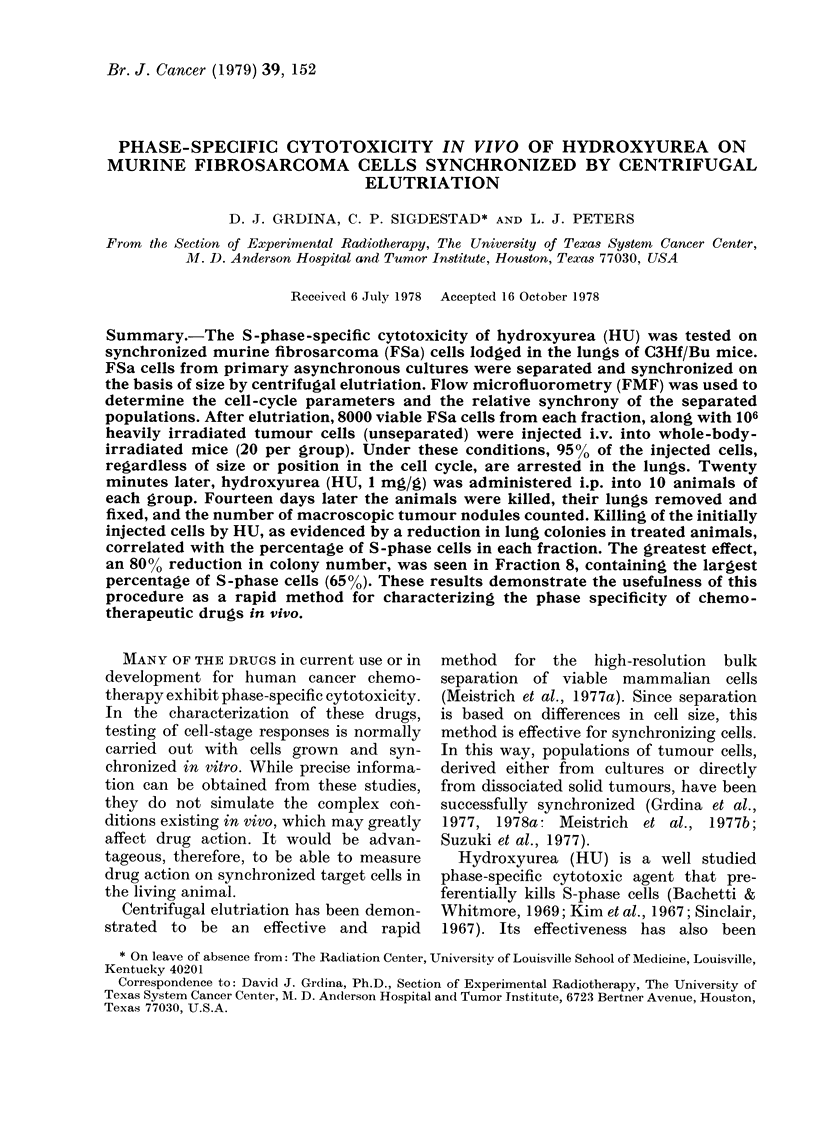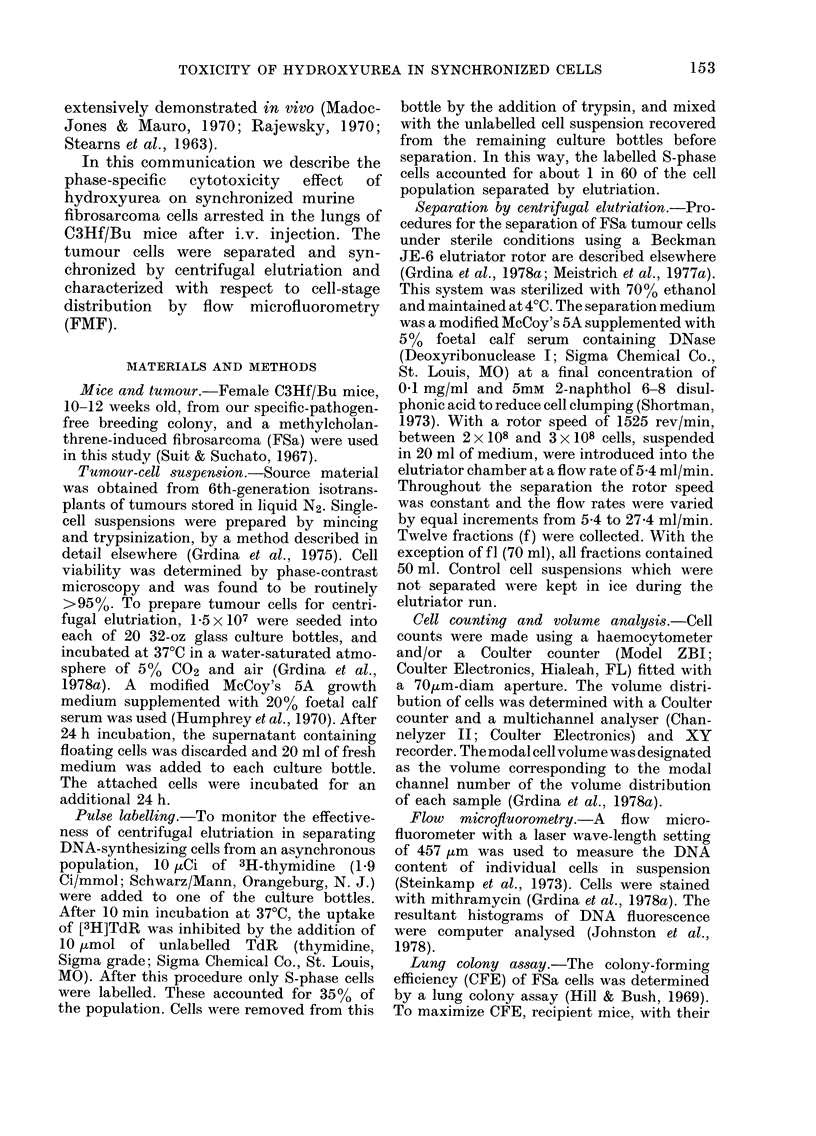Abstract
The S-phase-specific cytotoxicity of hydroxyurea (HU) was tested on synchronized murine fibrosarcoma (FSa) cells lodged in the lungs of C3Hf/Bu mice. FSa cells from primary asynchronous cultures were separated and synchronized on the basis of size by centrifugal elutriation. Flow microfluorometry (FMF) was used to determine the cell-cycle parameters and the relative synchrony of the separated populations. After elutriation, 8000 viable FSa cells from each fraction, along with 10(6) heavily irradiated tumour cells (unseparated) were injected i.v. into whole-body-irradiated mice (20 per group). Under these conditions, 95% of the injected cells, regardless of size or position in the cell cycle, are arrested in the lungs. Twenty minutes later, hydroxyurea (HU, 1 mg/g) was administered i.p. into 10 animals of each group. Fourteen days later the animals were killed, their lungs removed and fixed, and the number of macroscopic tumour nodules counted. Killing of the initially injected cells by HU, as evidenced by a reduction in lung colonies in treated animals, correlated with the precentage of S-phase cells in each fraction. The greatest effect, an 80% reduction in colony number, was seen in Fraction 8, containing the largest percentage of S-phase cells (65%). These results demonstrate the usefulness of this procedure as a rapid method for characterizing the phase specificity of chemotherapeutic drugs in vivo.
Full text
PDF






Selected References
These references are in PubMed. This may not be the complete list of references from this article.
- Grdina D. J., Basic I., Mason K. A., Withers H. R. Radiation response of clonogenic cell populations separated from fibrosarcoma. Radiat Res. 1975 Sep;63(3):483–493. [PubMed] [Google Scholar]
- Grdina D. J., Hittelman W. N., White R. A., Meistrich M. L. Relevance of density, size and DNA content of tumour cells to the lung colony assay. Br J Cancer. 1977 Dec;36(6):659–669. doi: 10.1038/bjc.1977.248. [DOI] [PMC free article] [PubMed] [Google Scholar]
- Grdina D. J., Peters L. J., Jones S., Chan E. Separation of cells from a murine fibrosarcoma on the basis of size. I. Relationship between cell size and age as modified by growth in vivo or in vitro. J Natl Cancer Inst. 1978 Jul;61(1):209–214. doi: 10.1093/jnci/61.1.209. [DOI] [PubMed] [Google Scholar]
- Grdina D. J., Peters L. J., Jones S., Chan E. Separation of cells from a murine fibrosarcoma on the basis of size. II. Differential effects of cell size and age on lung retention and colony formation in normal and preconditioned mice. J Natl Cancer Inst. 1978 Jul;61(1):215–220. doi: 10.1093/jnci/61.1.215. [DOI] [PubMed] [Google Scholar]
- Hill R. P., Bush R. S. A lung-colony assay to determine the radiosensitivity of cells of a solid tumour. Int J Radiat Biol Relat Stud Phys Chem Med. 1969 Jul;15(5):435–444. doi: 10.1080/09553006914550721. [DOI] [PubMed] [Google Scholar]
- Johnston D. A., White R. A., Barlogie B. Automatic processing and interpretation of DNA distributions: comparison of several techniques. Comput Biomed Res. 1978 Aug;11(4):393–404. doi: 10.1016/0010-4809(78)90020-4. [DOI] [PubMed] [Google Scholar]
- Kim J. H., Gelbard A. S., Perez A. G. Action of hydroxyurea on the nucleic acid metabolism and viability of HeLa cells. Cancer Res. 1967 Jul;27(7):1301–1305. [PubMed] [Google Scholar]
- Madoc-Jones H., Mauro F. Age responses to x rays, Vinca alkaloids, and hydroxyurea of murine lymphoma cells synchronized in vivo. J Natl Cancer Inst. 1970 Dec;45(6):1131–1143. [PubMed] [Google Scholar]
- Meistrich M. L., Grdina D. J., Meyn R. E., Barlogie B. Separation of cells from mouse solid tumors by centrifugal elutriation. Cancer Res. 1977 Dec;37(12):4291–4296. [PubMed] [Google Scholar]
- Meistrich M. L., Meyn R. E., Barlogie B. Synchronization of mouse L-P59 cells by centrifugal elutriation separation. Exp Cell Res. 1977 Mar 1;105(1):169–177. doi: 10.1016/0014-4827(77)90163-x. [DOI] [PubMed] [Google Scholar]
- Pfeiffer S. E., Tolmach L. J. Inhibition of DNA synthesis in HeLa cells by hydroxyurea. Cancer Res. 1967 Jan;27(1):124–129. [PubMed] [Google Scholar]
- Rockwell S., Frindel E., Tubiana M. A technique for determining the proportion of the clonogenic cells in S phase in ENT6 cell cultures and tumors. Cell Tissue Kinet. 1976 Jul;9(4):313–323. doi: 10.1111/j.1365-2184.1976.tb01279.x. [DOI] [PubMed] [Google Scholar]
- STEARNS B., LOSEE K. A., BERNSTEIN J. HYDROXYUREA. A NEW TYPE OF POTENTIAL ANTITUMOR AGENT. J Med Chem. 1963 Mar;6:201–201. doi: 10.1021/jm00338a026. [DOI] [PubMed] [Google Scholar]
- Sinclair W. K. Hydroxyurea: effects on Chinese hamster cells grown in culture. Cancer Res. 1967 Feb;27(2):297–308. [PubMed] [Google Scholar]
- Steinkamp J. A., Fulwyler M. J., Coulter J. R., Hiebert R. D., Horney J. L., Mullancy P. F. A new multiparameter separator for microscopic particles and biological cells. Rev Sci Instrum. 1973 Sep;44(9):1301–1310. doi: 10.1063/1.1686375. [DOI] [PubMed] [Google Scholar]
- Suit H. D., Suchato C. Hyperbaric oxygen and radiotherapy of a fibrosarcoma and of a squamous-cell carcinoma of C3H mice. Radiology. 1967 Oct;89(4):713–719. doi: 10.1148/89.4.713. [DOI] [PubMed] [Google Scholar]
- Suzuki N., Frapart M., Grdina D. J., Meistrich M. L., Withers H. R. Cell cycle dependency of metastatic lung colony formation. Cancer Res. 1977 Oct;37(10):3690–3693. [PubMed] [Google Scholar]


